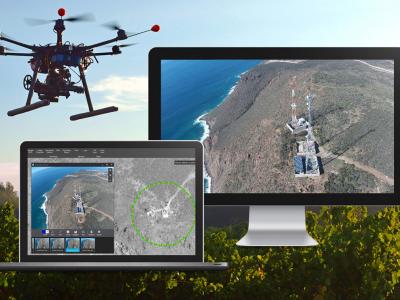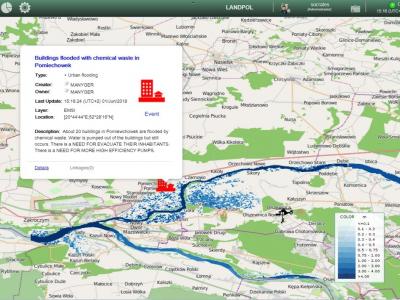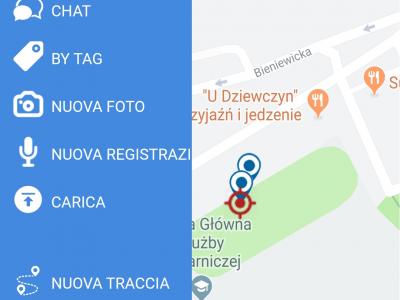Contact
The Final Demonstration is implemented in the form of an integrated event placed in multiple locations (three physically distant locations in two countries: The Netherlands and Poland).
The
will be focusing on information exchange among the EUCP Modules, EUCPT (closely linked to TAST) and LEMA as well as situation reporting to ERCC.
Large Forest Fires (FF) are spreading in a fictional, non-EU country “X”. National
capabilities of country “X” are not sufficient to manage the FF.
- Request for an assistance is prepared by country “X” and EUCPM is activated.
- Modules and assets are offered by the Member States.
- Upon acceptance of the modules, country “X” LEMA is working closely with EUCPT on site.
Upon arrival, EUCPT identifies another important issue: large unofficial refugee settlement is endangered by fire spread and in upcoming days it will be necessary to evacuate it (and defend it from the fire during the evacuation). Unexpected to relocate thousands of refugees adds to overall complexity and results in stronger EU-UN cooperation.
The will be focusing on information exchange among the EUCP Modules, EUCPT (closely linked to TAST) and NDMA as well as situation reporting to ERCC.
Gaps
Shortcomings in interoperability: the ability to exchange crisis-related information among agencies and organisations
This is aiming most of all at the reporting between EUCPT and ERCC. However, in order to best mirror the complexity of UCPM – Module reporting will be also taken into account.
Adequate COP environment
A Common Operational Picture (COP) is a particular type of situation supported by a Command and Control system which is “established and maintained by gathering, collating, synthesizing, and disseminating incident information to all appropriate parties.” (21).
The main challenges lay in the amount of data and therefore the selection the most relevant data for incident ; and the format of data (disparate data collection, integration and analysis). The information needs to be customised to the exact needs and discipline-specific requirements to accommodate the variety of users. Real time is crucial.
The objectives of a COP are ultimately to increase situational awareness and to support real-time decision making.
References in the literature: This
is rather well identified by most studies on
management
gaps. They tend to focus on the management of large amount of data and ability to merge data with different formats.
Final Demo general purposes are:
- To identify Management gaps related to high-level command at international level.
- To assess selected solutions interesting for ERCC and DRMKC and their usability in .
- To demonstrate and promote the methodology developed by the DRIVER+ project at the level of European Union (UCPM).
Final Demo purposes are:
- To present the DRIVER+ outcomes for the ERCC and at a European level.
- It will address this field by increasing the effectiveness of work of analysis teams in producing and harmonising a Common Operational Picture among entities on a European level. The scope is to showcase the potential benefits on coordination, information exchange, enhancement of a common operational picture, situation , resource management, communication and other gaps, as indicated by the participating End Users.
- The Final Demonstration will present the potential of a more integrated high-level CM system in Europe, especially in cross-border contexts in term of improved situation , coordination, resource pooling and sharing, and cross border cooperation.
Objectives
To verify if there is more effective exchange of information in the reports sent by EUCPT to ERCC.
To verify if there is more effective exchange of information in the reports sent by EUCPT to ERCC.
To verify if the situational awareness is increased due to integrated information environment available for EUCPT.
To verify if the situational awareness is increased due to integrated information environment available for EUCPT.
To verify if the use of the demonstrated solutions shortens the time of decision making.
To verify if the use of the demonstrated solutions shortens the time of decision making.
To verify if more structured information increases situation awareness and results in more efficient decision making.
To verify if more structured information increases situation awareness and results in more efficient decision making.
To verify if providing up to date map information shortens the time of terrain reconnaissance.
To verify if providing up to date map information shortens the time of terrain reconnaissance.
Scenarios
Large Forest Fires (FF) are spreading in a fictional, non-EU country “X”. National capabilities of country “X” are not sufficient to manage the FF. Request for an assistance is prepared by country “X” and EUCPM is activated. Modules and assets are offered by the Member States. Upon acceptance of the modules, country “X” LEMA is working closely with EUCPT on site. The will be focusing on information exchange among the EUCP Modules, EUCPT (closely linked to TAST) and LEMA as well as situation reporting to ERCC.
 |
Portfolio of Solutions web site has been initially developed in the scope of DRIVER+ project. Today, the service is managed by AIT Austrian Institute of Technology GmbH., for the benefit of the European Management. PoS is endorsed and supported by the Disaster Competence Network Austria (DCNA) as well as by the STAMINA and TeamAware H2020 projects. |





